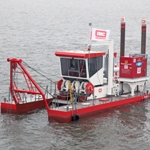Sustainable Dredging Premiere
 IHC Merwede has announced that alternative fuels have been used in the dredging process for the first time. The company ran a pilot test in which energy derived from hydrogen was the sole energy source used to power the electrical equipment on one of the latest generation of standard cutter suction dredgers: the IHC Beaver 40. The sustainable energy test took place at the Haringvliet estuary in the Netherlands.
IHC Merwede has announced that alternative fuels have been used in the dredging process for the first time. The company ran a pilot test in which energy derived from hydrogen was the sole energy source used to power the electrical equipment on one of the latest generation of standard cutter suction dredgers: the IHC Beaver 40. The sustainable energy test took place at the Haringvliet estuary in the Netherlands.
The hydrogen energy was supplied by the Purity fuel cell generator that has been developed by Bredenoord. Connecting a fuel cell to a dredger had not been tested previously and it needed to operate under the difficult conditions that are typical of the dredging process – vibrations, dust, water, frost and wave motion. The fuel cell successfully powered the dredger for approximately 120 hours. IHC Merwede Manager of Projects & Development Marcel Boor says: “The pilot test demonstrates that alternative energy sources can be applied to power dredgers.”
Emission free
The electrical equipment on the current line-up of ships is powered by diesel generators, which results in the emission of harmful substances. The use of fuel cells is emission free, as the hydrogen is converted into heat, electricity and clean water. One of IHC Merwede’s main aims is to construct sustainable vessels. The new IHC Beaver 40 for example has been fitted with LED lighting and the use of high-grade materials means that these ships require less maintenance. “Worldwide dredging projects need to meet increasingly stringent environmental demands”, says Dingeman van Woerden, Head of Product Development at IHC Merwede. “Our customers ask us to come up with solutions on a wide range of dredging tasks and this successful test is another step closer to sustainable dredging.”
Positive Outcome
Paul Schurink, Bredenoord’s Business Development Manager, shares IHC Merwede’s enthusiasm for the project, “It was important to find out how the Purity would perform on a surface that was moving and vibrating. “The fact that the fuel cell aggregate held up well under these circumstances means this hydrogen solution is suitable for a broad range of applications. The positive outcome of the test shows that the mobile hydrogen technique – developed by Bredenoord – can also be used in the offshore sector. In this way, the innovative aggregate contributes to the necessary transition to more sustainable sources of energy.”






